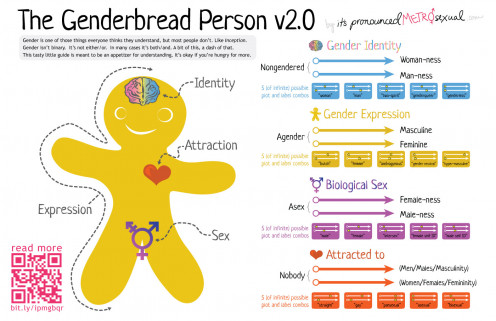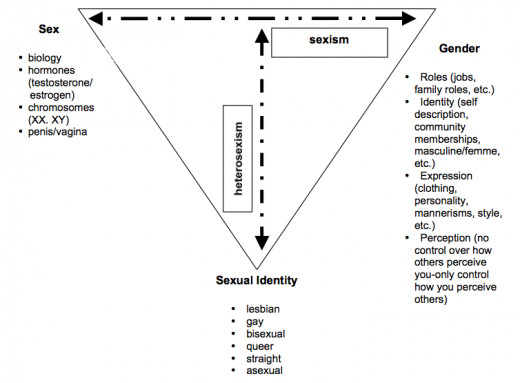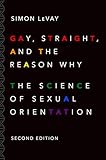Differences Between Gender Identity, Biological Sex and Sexual Attraction

Learn the Terms
Is gender and sexual identity a synonymous term? You might ask why is that important and why does it matter. Well think about filling out a form that requires a person to mark a male or female box, as those are still the only two available options on may forms. What happens with the person that does not identify on that spectrum then are they underrepresented and misrepresented? That may bring about some confusion and may cause personal non-empathetic labels to be attached to a person. Terms that relate to one’s gender, sex, and sexual orientation may not always fit an individual’s internal representation of self. So how does society think outside the box. Understanding terminology correctly and how to identify a person is a good start. Allowing an individual to describe their personal take on gender and sexuality roles for themselves help to reduce unneeded and unwanted labels. Education in regard to terminology is essential in learning how to appropriately and empathetically identify a person. The “identification” again is not for you but to show empathy that you are at least attempting to understand their self-narrative. Terms that relate to how a person may identify in accordance to what was previously referred to as a sexual dichotomy will be explained below in an attempt to broaden the readers understanding of gender, sex, and sexual orientation. One important rule is to begin removing the engrained male/female dichotomized boxes from our minds and learn a little bit of fluidity when thinking in these terms.

Gender
Commonly referred to the outward perception of a person such as roles, one’s femininity or masculinity and how they express themselves with clothing. So for an example a person dressed in slacks and a tie is perceived as a male or having masculine traits, whereas when one thinks of a caretaking position a female frequently comes to mind. An error frequently made is assuming that gender and sex are one the same. Below will describe the differences between the two terms.
Sex
Directly related to a person’s body parts (i.e. penis or vagina and breasts) and their biological makeup. However, during the transformation of assigned genitalia, transgender individuals may begin going by a different sexual identity than known previously. To be empathetic to an individual who is in the process of transitioning allow that person to identify in the manner that makes them most comfortable. For many transgender individuals, sexual identity may prove to be confusing and may bring about some uncertainty. For example, a male-to-female transgender person who may still have a penis but who is taking female hormone therapy may choose to identify herself as female. Being empathetic to that person is it best to address that individual as female.

Sexual Orientation
Different from the two above terms, sexual orientation refers to whom an individual is sexually attracted to. Terms frequently used for sexual orientation include lesbian, gay, heterosexual, bisexual, pansexual, and asexual. Therefore, thinking in dichotomous terms has the tendency to place limits on an individual and that does not allow the person to be taken in their entirety. For example, a female-to-male transgender who identifies as male, though still has female genitalia, could be considered gay (sexually attracted to males).
- Sexual Identity, Gender Development and the Later Ye...
While most theories of gender development explain sexual identity as being developed primarily in childhood, many of the factors affecting sexual identity are apparent to individuals throughout the entire lifespan. And while some studies show that... - The Truth about Gender
Biology does influence gender behavior, but does not determine how a specific gender may behave. Other factors contribute to the development biologically and environmentally to shape behavior.
How To Approach A Person In An Empathetic Manner
First and foremost, the best practice is to never make assumptions from your perception about how a person envisions himself or herself. Do not be afraid to ask about how that person identifies if it is pertinent to your interaction with that person. As a way to not label others make sure that you inquire about gender, sex, and sexual orientation as they are all different as detailed above. If the person you are speaking with is not aware that these terms are in fact different, educating them may be appropriate.
Remember That We Are In A Sexist Society
The foundation of Western society and the values, morals and way of living that are based on a male perception. Therefore, males have immediate privileges in this society that are not readily offered to minorities (i.e. ethnicity, women, homosexuals, and transgender individuals). In addition, children are taught prepubescent (prior to puberty) that heterosexuality is the norm and thereby has the tendency to experience internalized stigma in times when they do not fit into these societal views. As a result, those that do not fit the blueprint of the heterosexual model may be subjected to discrimination either overtly or covertly. Below is a diagram that demonstrates how these terms are not interchangeable and that the term “sex” is no longer dichotomous but rather a spectrum that must be identified by the individual themselves.

In Closing
Personal empathy is a very important tool to use when communicating with others. Important in personal and professional relationships, empathy can be used to understand those in your life. Educating yourself about gender, sex and sexual orientation is a handy instrument used to understand those around you and to help people feel comforted no matter the situation. It only remains confusing for those that continuing boxing up those terms and not letting them free for personal interpretation. Lastly, gender relates to a role, sex identifies body parts, and sexual orientation focuses on attraction. Hope this information was simple enough to comprehend and repeat to others.










